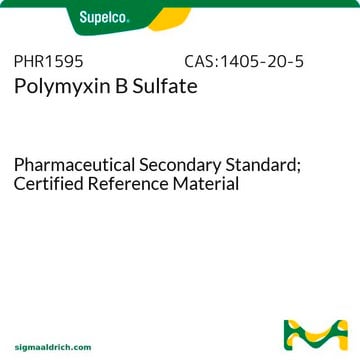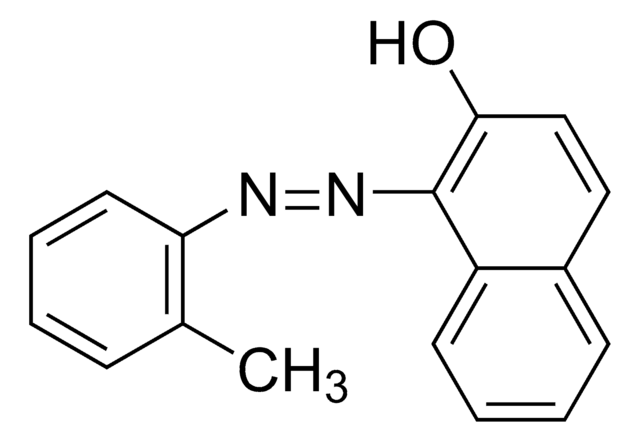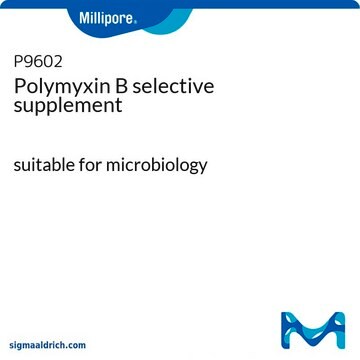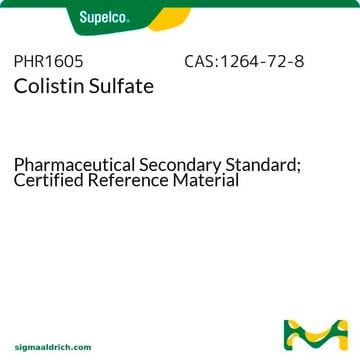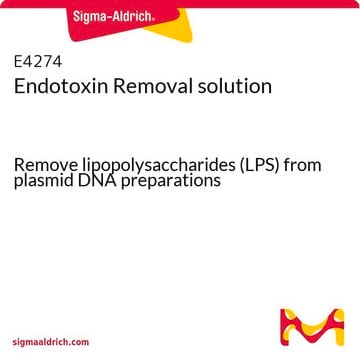81271
Polymyxin B solution
1 mg/mL in H2O, analytical standard
About This Item
Produits recommandés
Qualité
analytical standard
Niveau de qualité
Concentration
1 mg/mL in H2O
Technique(s)
HPLC: suitable
gas chromatography (GC): suitable
Spectre d'activité de l'antibiotique
Gram-negative bacteria
Gram-positive bacteria
fungi
Application(s)
pharmaceutical (small molecule)
Format
single component solution
Mode d’action
cell membrane | interferes
Température de stockage
2-8°C
InChI
1S/C48H82N16O13.H2O4S/c1-27(2)24-37-47(76)59-32(11-19-52)41(70)56-31(10-18-51)43(72)61-35(14-22-65)39(68)54-21-13-34(45(74)57-33(12-20-53)44(73)64-38(48(77)63-37)25-28-6-4-3-5-7-28)60-42(71)30(9-17-50)58-46(75)36(15-23-66)62-40(69)29(8-16-49)55-26-67;1-5(2,3)4/h3-7,26-27,29-38,65-66H,8-25,49-53H2,1-2H3,(H,54,68)(H,55,67)(H,56,70)(H,57,74)(H,58,75)(H,59,76)(H,60,71)(H,61,72)(H,62,69)(H,63,77)(H,64,73);(H2,1,2,3,4)
Clé InChI
HNDFYNOVSOOGDU-UHFFFAOYSA-N
Vous recherchez des produits similaires ? Visite Guide de comparaison des produits
Description générale
Application
Actions biochimiques/physiologiques
Mode of Resistance: The activity of Polymyxin B sulfate is inhibited by iron(II), Co(II), Mn(II) and Magnesium ions. Polymyxin B may also be incompaitible with other microbial agents, including amphoterecin, cephalothin sodium, cephasolin sodium and heparin sodium.
Antimicrobial Spectrum: Has bactericidal action on most gram-negative bacilli, including E. Coli and on most fungi and gram-positive bacteria.
Notes préparatoires
Code de la classe de stockage
12 - Non Combustible Liquids
Classe de danger pour l'eau (WGK)
WGK 2
Point d'éclair (°F)
Not applicable
Point d'éclair (°C)
Not applicable
Équipement de protection individuelle
Eyeshields, Faceshields, Gloves
Choose from one of the most recent versions:
Déjà en possession de ce produit ?
Retrouvez la documentation relative aux produits que vous avez récemment achetés dans la Bibliothèque de documents.
Les clients ont également consulté
Notre équipe de scientifiques dispose d'une expérience dans tous les secteurs de la recherche, notamment en sciences de la vie, science des matériaux, synthèse chimique, chromatographie, analyse et dans de nombreux autres domaines..
Contacter notre Service technique
